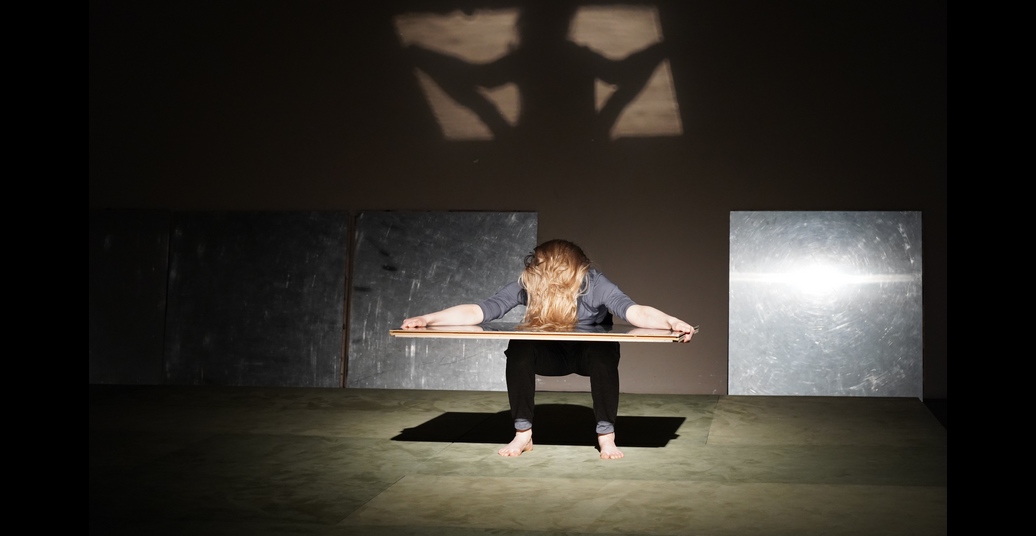With the showing “Mirroring” on 17 December 2022 in Tanzhalle Wiesenburg, Isabelle Schad and Josephine Findeisen provided some first impressions of a solo piece in the making: an assemblage of movements of the body and their visual and acoustic traces.
Heavy, unwieldy metal plates line the rear and left walls of the studio, forming a doubled wall — cold, forbidding — that seems immovable. Light bounces off their sometimes dull, sometimes iridescent surfaces without really being reflected by them. The dancer Josephine Findeisen braces herself against them, plate after plate applying the weight of her body to the dense, inflexible material that does not yield nor budge. Her feet keep slipping on the soft surface of the aikido mats that define a small stage space. Like ghosts, Josephine’s shadows appear now and then on the wall, underscoring the cold, distant, absorbed atmosphere that marks the beginning of the work-in-progress showing of “Mirroring” in the Tanzhalle Wiesenburg.
A nearly empty stage space, an abandoned non-place marked off by these mysterious metal formations that do not reflect, but dully bounce back a light in which somewhere a presence from something that once was there or which we at least imagine to have been there shimmers? An impression that’s staged visually, yes, but even more so acoustically— for Josephine Findeisen’s movements leave acoustic traces: captured (at the moment of occurrence) by microphones distributed throughout the floor, they form soundtracks that expand the space through their relationship to the physicality of the moving body. At the same time, they shift our sense of time. Less as a sequence of loops than a continuous emergence, arrangement, and dissolution of noise fragments, they suggest a temporal disjunction: loops that immediately disintegrate as soon as they materialize. “Sound and image flakes falling like luminous grey snow – falling softly from demagnetized patterns into blue silence,” writes William S. Burroughs somewhere in The Ticket that Exploded.
At some point Josephine manages to extract one of the plates from its position. She hoists it up, drags it across the floor, and takes it in her arms. With her upper body bent over the now illuminated plate, she appears to peer deep into her own blurry reflection on the metal surface. Spatial boundaries overlap — and open up. To the back, at the studio wall, a shadowy figure appears, clear and distinct: as reflection, as ghost, as a trace, as illusory opening in which memories of unredeemed pasts and a spectral glimpse of a future that might befall us are superimposed. Reflections, shadows, and their distortions expand the space in multiple directions, open up temporal depths and possible metamorphoses…
I saw Josephine Findeisen perform for the first time in 2016, in Isabelle Schad’s group piece “Pieces & Elements.” At the time, I lived directly across from the Wiesenburg. I was still studying and wrote a seminar paper (which I find very difficult to understand today) in which I connected that work of Schad’s with practices from quantum physics (what happened to this hype, by the way?) and Karen Barad’s concepts of diffraction and intra-action. In it, I wrote: “The performers do not interact — because they are not individuals — they intra-act — because they are only bodies that produce themselves reciprocally with other bodies in the space.” My instructor at the time left me this bit of critique: “Formulate this more precisely: because they’re no longer participating with their individuality — something like that.” Six years and a few group and solo works later, in this research phase of Isabelle Schad’s “Mirroring” it is primarily the acoustic-spatial structures and their entanglement with phantoms and shadowy specters that shift the boundaries between self and environment, between realities and their traces.
English translation by Cory Tamler




